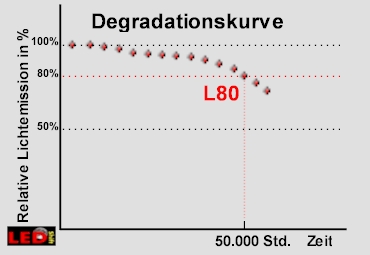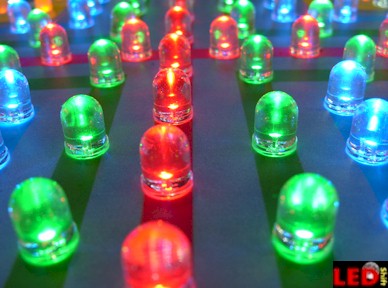 www.LED
www.LED |
|
|
|
|
|
LIVESPAN of an LED
 The light degradation of an LED is defined as the time, in which the luminus flux (lm) falls below 50% (median)of the measured origin luminus flux with defined ambient temperature and passage current.
The light degradation of an LED is defined as the time, in which the luminus flux (lm) falls below 50% (median)of the measured origin luminus flux with defined ambient temperature and passage current.
LEDs are not only energysaving and shockproofed they also have an enormously long lifespan up to 10.000.000.000 hours.
This value is produced however only on laboratory conditions. Usually the lifespan of one „household LED“ amounts between 10.000 and 100.000 hours. And that´s a big different!
LEDs behave however not like a bulb, with that the shining wire mostly „breaks“ but the luminus flux (lumen) of an LED decrease with the time. This continuous change is measurable and designated as DEGRADATION.
This light degradation is also as „lumen maintenance“ (L) mentioned.
LIVESPAN:
![]() The main cause lies in the enlargement of defects in the crystal, which supply on thermal influence, as to high temperature. These defects do not participate any more in the light generation and the LED lose in luminus flux, thus in brightness.
The main cause lies in the enlargement of defects in the crystal, which supply on thermal influence, as to high temperature. These defects do not participate any more in the light generation and the LED lose in luminus flux, thus in brightness.
![]() The second cause, which plays however a subordinated role, is the turbidity housings or the lenses if these are manufactured of plastics. Such turbidity arise however appears only with gallium nitride LED within the blue and ultraviolet range.
The second cause, which plays however a subordinated role, is the turbidity housings or the lenses if these are manufactured of plastics. Such turbidity arise however appears only with gallium nitride LED within the blue and ultraviolet range.
![]() The 3 cause can be a malfunctioning due the symptom of fatigue in the used materials. For example, fatigue symptoms of sticking or ground connections.
The 3 cause can be a malfunctioning due the symptom of fatigue in the used materials. For example, fatigue symptoms of sticking or ground connections.
These malfunctionings are described under the term „Mortality“(B) or total failure. At 100,000 hr. in the data sheet e.g. if B50 is located to an LED, this means that 50% of all test lamps has failed after 100,000 hr. Sometimes also the B10 value is indicated. That means from which time 10% of the test lamps dose not longer to function.
How the Degradation is indicated?

The light degradation of an LED is defined as the time, in which the luminus flix (lm) falls below 50% of the measured origin luminus flux with defined ambient temperature and passage current (L50). Many manufacturers indicate this value also as t50.
In addition, many LED manufacturers indicate ever more frequently a degradation of L70 or L80, which means that with a luminus flux loss of 30% (L70) or 20% (L80) the life span was exceeded.
For an LED if one life span is e.g. indicated by 50.000 hours, for a light degradation by L80, this does not mean for the final consumer that its LED makes after 50.000 hours „puff “and is broken, but that its LED only delivers after 50.000 hours burning duration still 80% original luminus flux. That is a lumen loss of 20%.
The Delegration by malfunctioning or also Mortality mentioned, gives the time and the portion of the failed construction units on (B50). This value has however mainly in the test phase of an LED a meaning and is in data sheets mostly not found.
 - LM-80 - Test Report Online + LM-80 Report + LM-80 Charts |
20.Okt.2009: LM-80 test reports are no longer a mystery. Philips Lumileds is now providing the LM-80 test report for its latest LUXEON Rebel LEDs online for everyone to access.
Lumen maintenance data is essential for predicting and understanding how LEDs will perform in actual use conditions.